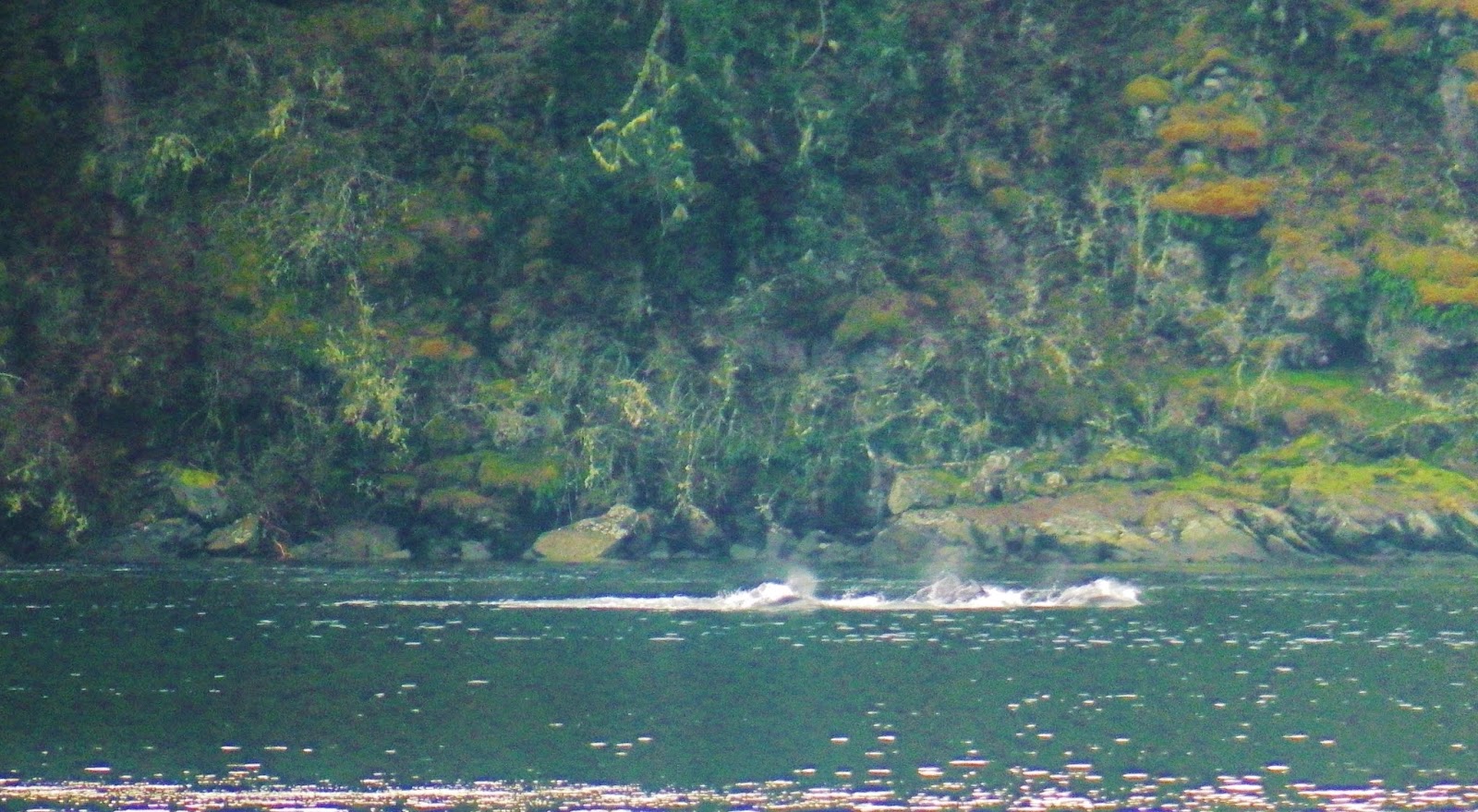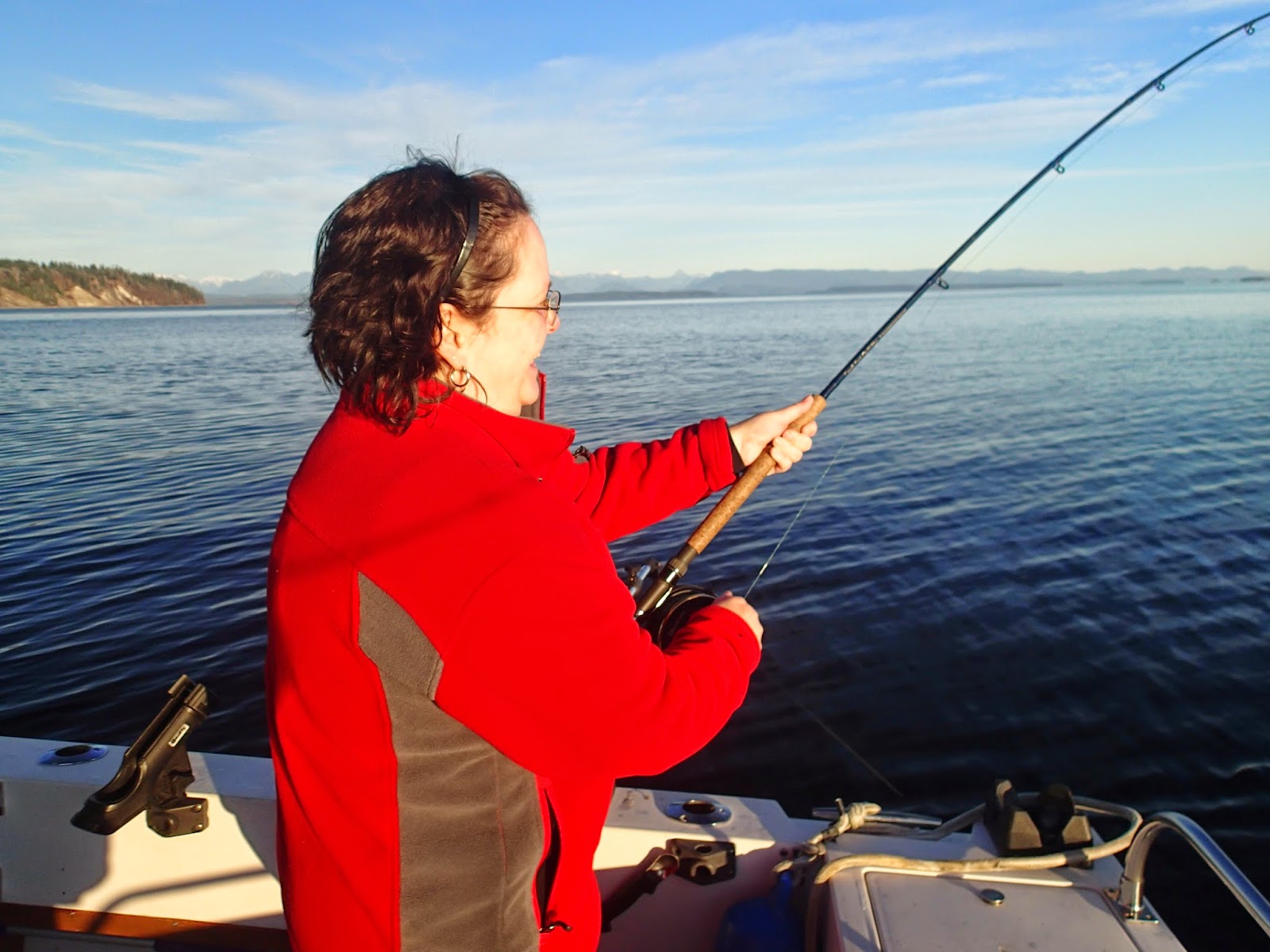250 830 8680
Saturday, 31 January 2015
Thursday, 29 January 2015
mild winter, hot fishing
Yes, Claude it really is January 29, write that on your licence to record your chinook catch. It's not much like your Ontario winter, but don't tell anyone.
The winter chinook fishing has just been very good and steady. These are "homesteading" chinooks that are finding lots of food right around here in Georgia Strait. This is such a positive indicator of good fishing to come from now through spring and summer. These fish are aggressive feeders, not shy, looking for action. We look for them, but they find us.
250 830 8680
Tuesday, 27 January 2015
smileys
250 830 8680
Friday, 23 January 2015
Bright Fish, Brightfish
A " bright fish " is what fishermen say to describe a salmon that is in it's prime. Each of the salmon species darkens into it's particular spawning colours in its own way. This process often starts while the fish is still migrating in the ocean. Some fish will be bright still even when entering their freshwater streams.
Thursday, 22 January 2015
Great bargain dollar rate for Americans
A Canadian dollar costs only 81 cents for Americans !
Or, the another way, 100 of your American dollars buys 124 Canadian dollars.
Wow, that is a big built- in discount for your fishing trip.
Tuesday, 20 January 2015
modern times
I'm just catching up with the technologies that some of you, like this Seattle couple, are so natural with.
250 830 8680
Sunday, 18 January 2015
morning dolphins
250 830 8680
Saturday, 17 January 2015
herring close by
Last blog I mentioned seeing herring off of the dock at night in mid-winter. If I could have got a photo it would look like this . These photos are from September.
Here small juvenile herring are feeding fearlessly, coming close, and not much bothered that mechanic Frank Delph is giving my kicker a tune-up. This behaviour demonstrates how fish act so aggressively in a "feeding frenzy" and opposite to their usual shy and easily spooked mode.
Massive schools of large mature herring will be coming into Georgia Strait from the outer ocean in late winter to spawn in concentrations, mostly around Denman Island and south, in the shallows in early March. That is a magnet for all kinds of wildlife and a terrific show . -Something for another post.
250 830 8680
Friday, 16 January 2015
Stars, urchins, murder
Sea Star wasting away,
Green urchins move in when their predator Sea Stars disappear. Recent photo from the dock in Quathiaski Cove.
Sea stars have been in a massive die-off called Sea Star
Wasting Syndrome, SSWS; that has been in the news. ( The newer ,better language is to call them sea stars,
not starfish ) The infection blew up the coast from California through Alaska in
just a couple of years. It was a mystery that seems to have been solved somewhat
last autumn by the bio-detectives identifying a virus. Luckily it seems that a
few survivors may be starting a slow rebuilding population. There is much more to this,
as you can find from the following links, and from Google.
Sea Stars are the keystone species that was first used to establish the concept
of keystone species. Locally, the effect to notice is that starfish eat sea
urchins, ( as well as other things such as bivalve clams). Urchins eat kelp
sprouts. Sea Stars gone, green urchins populations exploding, kelp down.
Kelp creates a very important forest-like environment to shelter all sorts
of creatures and small fish. People have been keenly noticing losses or gains
in kelp beds as indicators of ecosystems, prior or the starfish die-off. Kelp
is one of the greatest natural carbon storage systems. The previous well-known
story-line about kelp has been how early fur trade hunting of sea-otters, which
dine on urchins, has devastated kelp beds over the whole coast. So,
reintroductions and growing populations of sea-otters on the west coast is a good thing.
Winter survivor bull kelp, all alone on this part of the beach. The leafs are a fraction of their full size.
Kelp is important , and remarkable. It is actually algae , not a plant, and
the largest of that. It is an annual, and about the fastest growing plantish
thing in the world, with the stem able to grow up to 2 feet per day in ideal
conditions. The holdfast is a specialized root-like part that anchors the plant,
then the stipe ( stem) which can be 50-80 feet long, or more, the bulb ,which
contains enough carbon-monoxide to kill a chicken, and the long leaves near the
surface which collect sunlight for photo-synthesis. As a fast growing annual,
kelp usually dies in winter storms, but it is usual to start from scratch every
year. However, kelp that can survive winter can live for many years. Bull kelp
should get a lot more appreciation. http://themarinedetective.com/tag/bull-kelp/
Another cascading effect is that the unimpeded urchins are eating the
fringed colander kelp beds which provide sheltered habitat for juvenile spot
prawns. The massive carpets of urchins are called “urchin barrens” and scientists are concerned about how eliminated species will recover. http://www.aquablog.ca/2014/07/sea-star-wasting-syndrome-affecting-other-marine-life/
Here in Quathiaski Cove, the green urchins are taking over the bottom. It took me a while to get a decent good photo because the tide is fairly high in
daytime in winter. The photo at the top shows a dense cluster, this next one is more typical of the green urchins grazing.
This past autumn, there was a flock of crows,( a murder of crows ) hanging
around the docks in the north end of Quathiaski Cove, and crapping on the roofs,
as they have never done before. They were dining on green urchins which they
could pick at low tide, and ripe chestnuts from a nearby tree, a good balanced diet. Both of these
foods have shells that the crows cracked by dropping them on the docks, or the
rocky shore. If I could have got a good group photo of some of that action I would have titled it “ Murder
at Dinner.”
I don't want to leave this post sounding alarmist. The ecology may be
changing, it is complicated, and very interesting, I think. On the up side ,
chinook fishing right now in winter is as good as anyone remembers for decades, and
indicates the vitality of the sea. Winter chinook populations “inside’' predict
good local spring and summer resident chinook populations, which we measure a sample of with good fishing. I sometimes go down to the dock at night ,
especially around low slack, if is calm, and I can often see herring flashing.
That is another example of something clear to see, but hard to get a decent photo
of. Those Bright Fish give me a lift.
(photo credit: Starfish , aquablog.ca.,
(photo credit: Starfish , aquablog.ca.,
250 830 8680
Thursday, 15 January 2015
Wednesday, 14 January 2015
Campbell River Fishing Guides Association
the decal , from decades ago
I'm now the Chair of the Campbell River Guides Association.
How did this happen ? Harry MacDonald had been in the position for over ten years, and decided that was enough. A big thank you for all of that, Harry. The election was by acclamation, and I appreciate the confidence that the members have placed in me. Harry will carry on as Treasurer, and Jeremy Maynard has volunteered as Secretary.
There will be challenges, and good times too, as the cursed blessing goes, " May you live in interesting times."
250 830 8680
Tuesday, 13 January 2015
Locals fishing mid-January
Fishing reports have been very good , so this Saturday Dec 10, quite a few local anglers got out fishing close to home. Photos from Willow Point.
250 830 8680
Monday, 12 January 2015
winter currents
In winter the tides are high, all day, and float driftwood off of the shores. With help from the winds , and currents there is a lot of wood in the water moving to new places.
After a big rainstorm, the wash from the Campbell River sometimes comes all the way across Discovery Passage into Quathiaski Cove at this time as the ebb starts pushing back into the passage.
250 830 8680
Sunday, 11 January 2015
Saturday, 10 January 2015
Winter waterfront ( new camera )
Sunrise reflected in the windows of Campbell River after a storm. View from Quadra Island. Note the boat washed ashore on Grouse Island.
Snow on the mountains, (where it belongs) .
I've got a new camera. I had lots of frustrations with the last one as the auto-focus started having problems, and it only had a short lens. I'm pretty happy with this one.
250 830 8680
Friday, 2 January 2015
December odd sample
As you may know, I have been taking tissue samples for DNA analysis. This is part of a program called Avid Anglers in which volunteers collect samples for DFO biologists to determine the rivers of origin of the chinooks and cohos. There are about two dozen such anglers, mostly on the south end of Vancouver Island. In this area there are only a few of us. The others are part time recreational anglers, and guide Jeremy, but he spends a significant part of his year in other areas as well.
Let me take this opportunity to say thank you to every one who helped out with the sampling in my boat , either by just being patient and supportive, or by actually getting involved in doing the holding , punching or recording. This past season I turned in 246 samples. I hope to get information back to share with you. The analysis will be done through the winter.
The tool for taking samples is a paper hole punch. You can see the previous punch healing and I took out the new punch just below it. There has been some discussion about how long it takes for such scars to heal and some experience from hatchery workers punching adult fish to count them
indicates they heal quickly.
This fish is already marked by its adipose fin being clipped, showing it to be a hatchery origin fish. Then there is the healing sample mark and then my sample. So this fish has been marked three times!
The length of this fish was just on the line of being legal. We released it, so there is a tiny chance it could be caught and identified again.
I had no record of a fish of this description, so inquired of the other local samplers but they had not marked it either. Inquiries are being made of the Avid Anglers from the south .
250 830 8680
November chinooks
Fishing was very good in November and December. The fish are bright feeders, chinooks that are living here , growing up. It sure looks like the fishing is going to stay good right through winter. This one is so bright that Ron has to squint. John is thinking this is going to taste so good. These "winter springs" are the tastiest salmon.
250 830 8680
October Q Cove and Discovery Passage pics
250 830 8680
Subscribe to:
Comments (Atom)

































